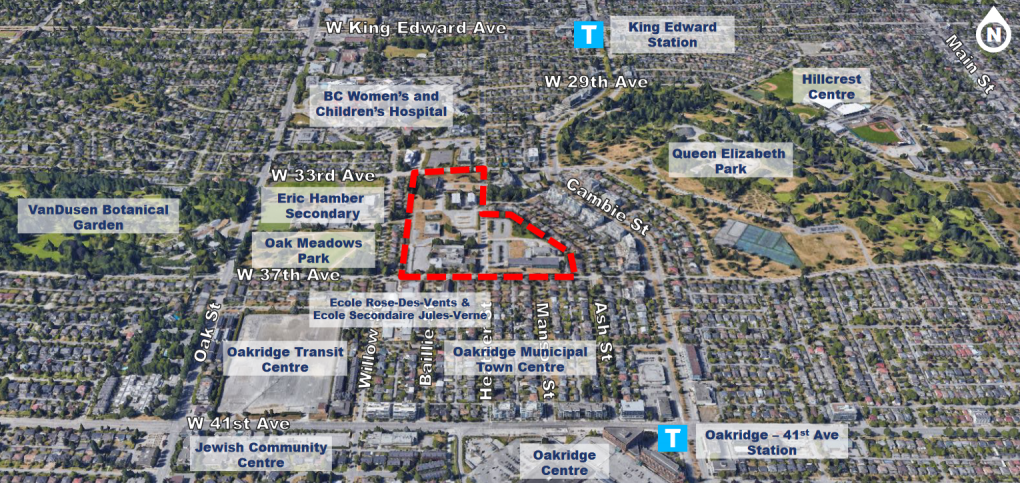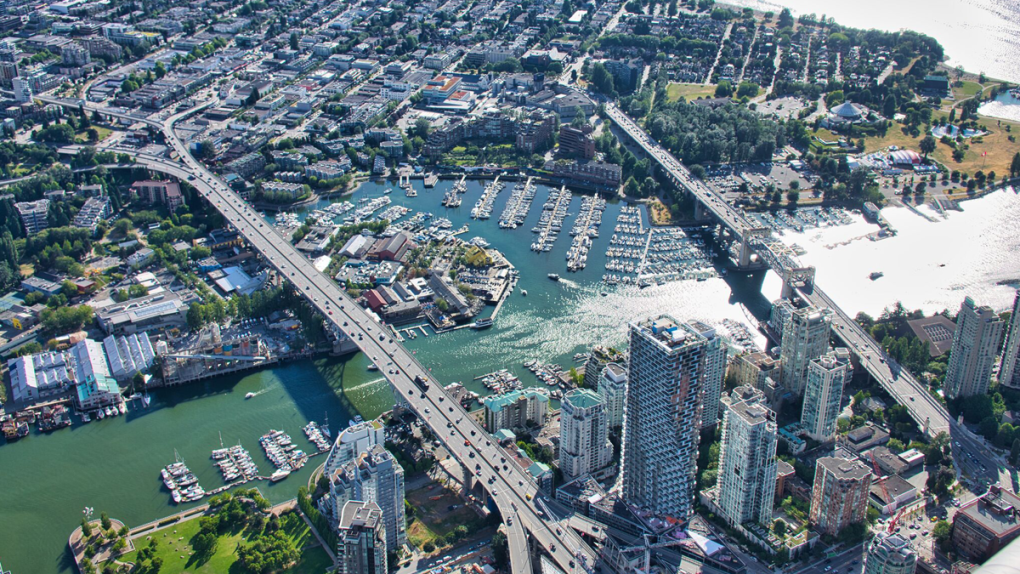'You of all people should understand,' Vancouver councillor tells Indigenous leader of removing Mountie's urn for construction
A meeting about a Vancouver redevelopment plan and the fate of a heritage building got a bit heated when a city councillor asked whether those behind the Indigenous-led project knew the remains of an RCMP officer were buried at the site.
The meeting was not about the remains. Its purpose was for council and the public to discuss with the project leaders what the major redevelopment, which includes hundreds of new housing units, will look like, and to determine whether the land should be rezoned.
But part of that plan includes what to do with an old building on the lot. City staffers had been asked at a previous meeting to look into whether it could, and should, be relocated.
It would cost nearly $50 million to move and upgrade the more-than-a-century-old building, city staff estimated while recommending that it instead be torn down.
According to a report presented at a public meeting last week by Kirsten Robinson, a senior planner with the city, the estimated cost of saving the Fairmont building, which is currently on the Heather Lands, would be "upwards of $47 million."
The building is listed in the city's heritage register in the "A" evaluation category, meaning the exterior is fully protected from inappropriate alteration. In some cases, buildings in this schedule are also protected from select interior and landscape alterations.
PHYSICAL REMINDER OF 'ATROCITIES'
The building exists on land that will be home to the city's largest-ever Indigenous-led redevelopment project, and its history includes being home to the RCMP as both the Fairmont Barracks and the Fairmont Training Academy.
It was built as the Langara School for Boys just before the First World War, City Coun. Colleen Hardwick said, then became a military hospital before it was an RCMP station.
She asked whether instead it should be repurposed, listing examples of other controversial buildings that remain standing with reconciliation in mind.
She said this after city staff described it as a physical symbol of the RCMP's role in enforcement of the Indian Act and other discriminatory laws against Indigenous peoples, and as a symbol of colonialism.
Adrienne Charlie of the Sḵwx̱wú7mesh (Squamish Nation) said it was part of a discussion as recently as the morning before the meeting. The meeting was just days after a gathering near the Kamloops Indian Residential School – one of these buildings – where the anniversary of the discovery of what are believed to be the remains of children was marked in a day-long ceremony.
"One of the hardest things that this country was built on was the overtaking of our land, and I think the biggest part is us taking back our land, and taking ownership of who we are as people," Charlie said.
"The atrocities that the RCMP have done to our people (were) so hard. Many of our family (members) never came home. Many of our children … The RCMP was built to help the country impede within our people, and I'm not saying that the churches weren't a part of it, and these schools weren't there. Our people are utilizing these buildings."
She said those behind the project have talked about moving it, and that they're willing to go along with that, "but I think the replacement of the cultural centre is what is important to us."
 A concept sketch from a proposal for the Heather Lands is shown.
A concept sketch from a proposal for the Heather Lands is shown.
'SO, PUT IT IN THE LANDFILL. THAT'S VERY GREEN.'
Still, the city directed its staffers to look into whether it was feasible to move it from the site, given that it is a historical building.
It is physically possible to relocate the building, staff said last week, but they were unable to find a suitable location within 1.5 kilometres of its current location. The search included nearby land slotted for redevelopment, public parks as well as single-family lots in the area.
And the cost would be tens of millions of dollars.
 The Heather Lands site is shown on a map included in a City of Vancouver presentation.
The Heather Lands site is shown on a map included in a City of Vancouver presentation.
Initially the project was estimated to require a budget of around $6 million just to move it, a staff member told council. That estimate was from 2017. The upgrades would cost another $41 million.
But given they'd have to move it further away than the 1.5-kilometre radius, the bill would likely be even higher, Robinson said.
And while the building is in the city's heritage register, it is not actually protected because the policy statement set by the previous council for the property supersedes the 2020 heritage policy, staff told council. Nor is that necessarily in the city's best interest "in the spirit of reconciliation."
Asked whether they'd considered the environmental impact of tearing the building down, staff said a full analysis was conducted and that the recommendation from the director of planning was to demolish it.
Instead, staff recommended the council approve removal of the building, to which Hardwick responded sarcastically, "So, put it in landfill. That's very green."
'EVIDENCE OF A BURIAL'
Hardwick said there was a "piece of correspondence" suggesting there was "evidence of a burial" on the site of at least one RCMP officer.
Robinson said veterans of the RCMP said there is believed to be an urn under the flagpole, but that those working on the site will remove the remains.
The question did not go over well with some in attendance.
Squamish Nation Coun. Syexwáliya Ann Whonnock said multiple members of her family were buried at the footing of the Burrard Street Bridge.
"No consideration was given for feelings and our families, and we were forced to dig them up and move them up to where our family lived, 25 miles up the Squamish River. Then the land was expropriated, given as a tree farm licence, and a logging road had to be constructed, and they were asked again to move the remains," she said.
 The Burrard Bridge and Granville Street Bridge are seen from the air in June 2019. (Pete Cline / CTV News Vancouver)
The Burrard Bridge and Granville Street Bridge are seen from the air in June 2019. (Pete Cline / CTV News Vancouver)
Whonnock said other families too have similar stories, so context is important.
"I just had to share that because you hit my heart when you said that," she said, telling the councillor no one thought about her deceased family members when their remains were dug up to help the city.
Hardwick said, "You of all people then would appreciate the sensitivity that the families would feel."
REMOVAL OR DEMOLITION?
By the end of the meeting, council approved the redevelopment plan that includes the removal of the Fairmont building, which will be replaced in a later phase of the project with an Indigenous cultural centre, but it's still unclear what will happen when it's removed.
A city spokesperson told CTV News that it's possible, though "unlikely given significant challenges" that an alternative site could be found before construction crews need it to be demolished.
Charlie said if someone was willing to pay to move it, the three First Nations would be willing to support the moving of the building.
CTVNews.ca Top Stories

Live election results: Trump retakes the White House, defeats Harris by winning key swing states
AP has declared the battleground state of Michigan for Trump. That completes his sweep of the 'Blue Wall' states that surround the Great Lakes.
Trump wins the White House in a political comeback rooted in appeals to frustrated voters
Donald Trump was elected the 47th president of the United States on Wednesday, an extraordinary comeback for a former president who refused to accept defeat four years ago, sparked a violent insurrection at the U.S. Capitol, was convicted of felony charges and survived two assassination attempts.
Read the full transcript of Donald Trump's victory speech
The former U.S. president and now president-elect addressed a crowd of supporters at his campaign headquarters in West Palm Beach, Fla., shortly after 2:30 a.m. EST, Wednesday morning.
'Canada will be absolutely fine': Justin Trudeau, his ministers and Pierre Poilievre congratulate Donald Trump
Canadian Prime Minister Justin Trudeau and members of his cabinet congratulated Donald Trump Wednesday morning on his second United States presidential election win, amid questions about how the federal government intends to navigate a second term.
4 ways in which Donald Trump's election was historic
Donald Trump's election victory was history-making in several respects, even as his defeat of U.S. Vice-President Kamala Harris prevented other firsts. She would have been the nation's first Black and South Asian woman to be president.
Who won the popular vote? U.S. election vote totals from the past 40 years
Donald Trump won the U.S. presidency on Tuesday, and as of Wednesday morning, was also ahead in the popular vote. Historically, though, the candidate with the most votes hasn’t always won the contest.
Calgary senior charged with sexual assaults of Canadian immigrant
Calgary police have charged a senior with sexual assault, and say the accused was a volunteer sponsor who helped families immigrate to Canada.
'How to move to Canada' surges on Google as U.S. wakes up to Donald Trump win
U.S. search engine queries about moving to Canada shot up Wednesday in the wake of Donald Trump’s decisive win in the presidential election.
Kamala Harris made a historic dash for the White House. Here's why she fell short.
It was a moment that encapsulated one of the biggest challenges facing U.S. Vice President Kamala Harris' campaign – which, in the end, proved insurmountable. A country crying out for change got a candidate who, at a crucial moment as more voters were tuning in, decided to soft-pedal the change she knew she represented.
































